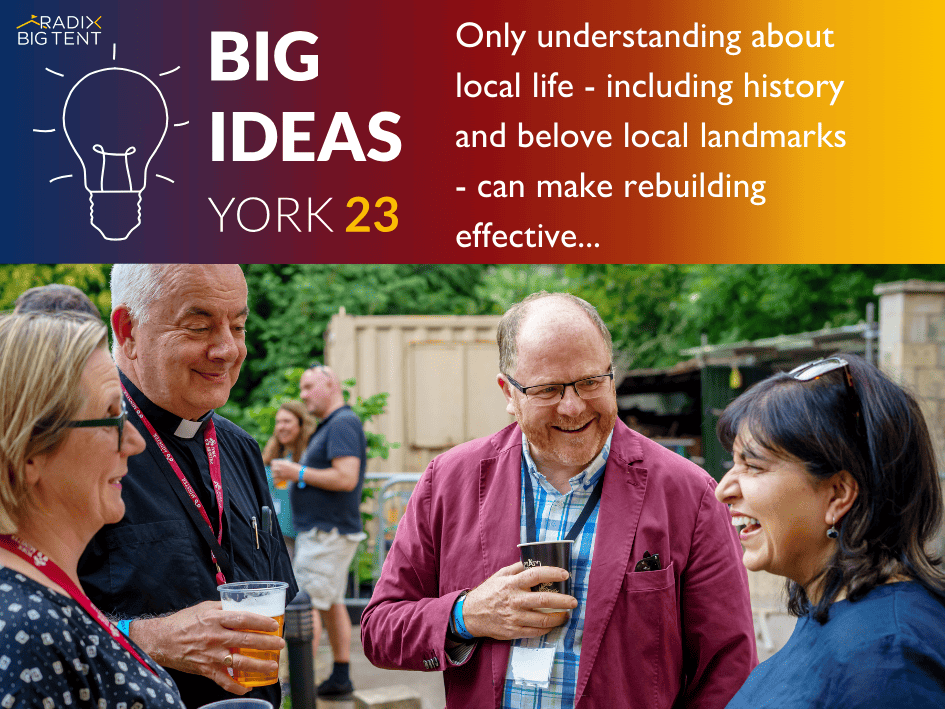York Big Ideas Festival report 1 (ECONOMIC AND PHYSICAL REGENERATION (in partnership with Aviva)).
View the other York Big Ideas Festival reports HERE.
Chair: Phil Bixby, YoCo.
Speakers: Greg Dyke, Chair, York Central Strategic Board
Jimm Reed, Leeds Community Homes on creating People Powered Homes
Josh Coates, Homebaked CLT, Liverpool
Sarah Hart, Community-led Homes, North Yorkshire & East Riding
Turning a much-loved local business into a symbol of regeneration, bringing skills and reputation to the table as ‘a bag of capital’ and harnessing the ‘resilience and tenacity’ of local people are key to the successful community-led rebuilding.
But new economic models are needed in a sector where there are few lenders and grants are becoming increasingly unavailable before ‘truly affordable’ homes can be built, a Radix debate on community-led futures heard.
A scheme that transformed a row of derelict Edwardian terraces into a community land trust (CLT) mix of modern homes and commercial units near Liverpool’s Anfield stadium had boosted its chances of success by recognising the power of a landmark bakery that had served bread, pies and cakes to generations of football fans.
Earmarked for development under a government housing renewal scheme that unexpectedly stalled in 2010, residents were left with ‘unfinished homes and a lasting sense of frustration,’ Josh Coates of Homebaked CLT said.
The closure of the bakery that had been at the heart of the community a year later spurred local people into action. They rented the building and used it for public discussion meetings. Within twelve months they had created a community land trust to build a new bakery on the site surrounded by affordable homes.
The decision to use the bakery as a hub for initial conversations was the key to success, he said. “People kept coming in and saying ‘Can I buy a loaf of bread?’ Their disappointment that the bakery had been shut down strengthened their resolve to use their own ideas to bring it back.
“All of the ideas for better living were created by community and designed by neighbours for their future neighbours. The community worked together to bring back bread to the neighbourhood,” Coates said.
But negotiating support for the scheme with Liverpool Council amid frequent elections and member changes had not been easy. “As soon as we felt our foot was in the door, something changed… we had to keep reintroducing ourselves. We’re knocking on the door quite a lot and obviously continual knocks can be quite annoying but it’s about building that mutual relationship with them.”
He was backed by Jimm (CORR) Reid of Leeds Community Homes, who urged the audience to aim for ‘amicable activism’. “A community can be a little bit of a loud irritant to the big stakeholders, the developers, the landowners. It’s about not crossing the line of becoming antagonistic. You have to be annoying enough for them to want to bring you inside the tent rather than have you outside the tent – and there is a bit of an art form to that.”
The biggest problem for small community organisations was not “being capitalised” – having money to start with, assets to work from or access to borrowing or grants – and having to do everything from the “bottom up”.
In order to “play the game at the same level as all the others” they should “build an asset base” through a reputation for ‘can-do’ and bring in physical investment through community share offers.
“The beauty of that is it really gives us a bag of capital to put on the table when we sit down and start talking to all the stakeholders.”
Greg Dyke, chair of York Central Strategic Board’s project to build up to 2,500 new homes and more than a million square feet of office, leisure and retail space on 45 hectares of land close to York railway station, agreed.
The first challenge was always to involve people and make sure it was being done “by and for the people – rather than being done to them,” he said. “Don’t fear people – don’t work from the basis that it’s all agit prop and that they are just trying to come in there and don’t understand your financial constraints,” he said.
Rural communities were a source of great resilience and tenacity, Sarah Hart, of Community Led Homes North Yorkshire and East Riding, said, because they “recognise” their community’s needs – and “just get on with it.”
“When you bring the community on board, you turn those ‘Nimbys’ into ‘Imbys’,” she said. She believed that cross-subsidy was one idea the government had “really been looking at. But she called for a new economic model that worked for everybody – not just the landowners but the community
“We live in a society where it seems the private rental sector is the default now because social housing isn’t available and we need to look at new models where we can sit down around the table with all stakeholders, where we all learn from each other and actually speak the same language.”





